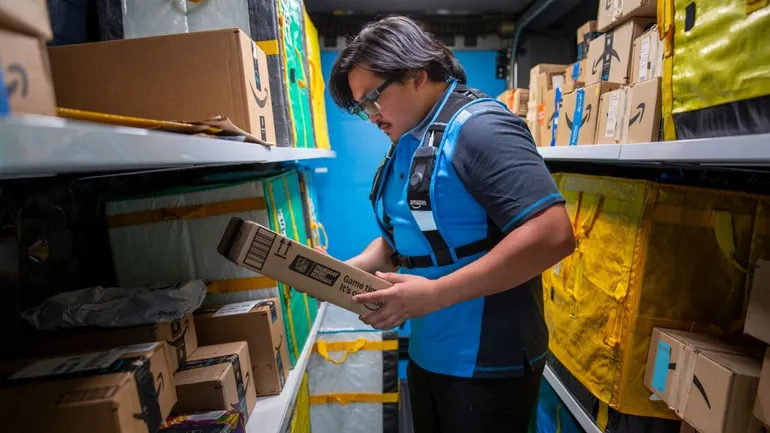
Amazon is testing new technologies, from a multi-arm robotic system to smart glasses for drivers, the company announced Wednesday.
According to the e-commerce giant, these innovations aim to reduce repetitive tasks, increase productivity and speed up delivery. They’re also taking advantage of other Amazon technology-driven advancements this year, including fulfillment center robots and better demand forecasting and delivery mapping.
Here’s a deeper look at Blue Jay, Project Eluna and Amazon’s smart delivery glasses, three of the company’s latest innovations that power its fulfillment network.
Blue J
Blue Jay is a system that coordinates multiple robotic arms to perform multiple item-handling tasks simultaneously, reducing frequent employee reaching and lifting, according to Amazon.
The system can manage the work of three separate robotic stations in a single workspace for picking, stacking and consolidating items, which helps the company save physical warehouse space. Blue Jay went from concept to production in less than a year, a tight timeline compared to the three-plus years required for other robotic systems such as Robin, Cardinal and Sparrow.
“The reason: Years of trial and error turned into months of development thanks to advances in artificial intelligence,” Amazon said. Our engineers were able to replicate dozens of prototypes for Blue Jay using digital twins.
Amazon is testing Blue Jay at a facility in South Carolina, where the system is currently able to handle about 75 percent of stored items. Over time, Amazon expects the technology to play a key role in delivery and same-day delivery sites.
Elona project
According to the company, Project Eluna is an artificial intelligence model that helps Amazon operations managers make more informed decisions about how to run the fulfillment process smoothly.
Amazon described the system as an additional teammate that is “designed to operate with a degree of autonomy, reasoning through complex operational situations and recommending actions to operators.” To do this, Project Eluna factors in real-time and historical construction data to predict potential fulfillment challenges and help managers keep facilities on track, according to the company.
Operators can ask questions like, “Where should we move people to avoid bottlenecks?” Amazon said and get clear, data-driven recommendations. “The goal: less firefighting, more foresight.”
Project Eluna is being piloted at a Tennessee fulfillment center to help operators during the holiday shipping rush, and will initially focus on sorting optimization, according to Amazon. Finally, the system supports preventive safety measures such as scheduling ergonomic employee rotations and improving maintenance schedules.
Smart delivery glasses
The company said the goal of Amazon’s smart delivery glasses is to help couriers focus on their surroundings, identify hazards more easily and move more efficiently to customers’ doorsteps.
The wearable system displays real-time navigation and instructions for delivery drivers, offering a hands-free process that reduces dependence on their phones. The glasses help drivers find and scan packages and follow step-by-step directions to their destination, which can be useful in navigating complex environments like apartment buildings, Amazon said.
The company said hundreds of delivery drivers tested early versions of the glasses, and their feedback shaped the next iteration of the system.
According to Amazon, we anticipate that future versions of the glasses will offer real-time fault detection, where the glasses can help drivers alert if they’ve mistakenly left a package on their doorstep that doesn’t match the house or apartment number on the package, detect hazards like low light and adjust the lenses, detect a pet in the yard, and more.